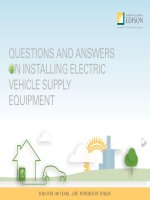QUESTIONS AND ANSWERS ON INSTALLING ELECTRIC VEHICLE SUPPLY EQUIPMENT ppt
Bạn đang xem bản rút gọn của tài liệu. Xem và tải ngay bản đầy đủ của tài liệu tại đây (1.15 MB, 16 trang )
FOR OVER 100 YEARS. LIFE. POWERED BY EDISON.
FOR OVER 100 YEARS…LIFE. POWERED BY EDISON.
QUESTIONS AND ANSWERS
ON INSTALLING ELECTRIC
VEHICLE SUPPLY
EQUIPMENT
Table of Contents:
2
Contact Information: We know you may have
some additional questions about EVSEs and
we’re here to help. Please contact us
at
or call 1800-4EV-INFO.
Plug-in Electric Vehicles are here, and more
are on the way. SCE wants to help make
charging them simple, safe and economical
for customers.
EVs offer the convenience and ease of
charging from home. But, there are several
decisions customers will need to make about
their home charging infrastructure before
they bring them home. SCE is working with
automakers, car dealers, electric vehicle
service providers and local cities to help
educate customers.
SCE has a comprehensive website to help
customers and cities understand the home
charging station installation process. Visit
www.sce.com/ev.
Typically, installing an electric vehicle supply
equipment (EVSE), commonly referred to
as EV charging stations, is a straightforward
process; however, unique challenges may
pop up. Following are answers to some
of the questions you may have about the
process.
I. Installing Charging Stations
II. Load Calculations and Analysis
III. Permitting
IV. Safety
V. Electric Rules and Service Requirements
VI. Second Meter Installations
VII. Miscellaneous
Intro
Helping Customers Navigate the Ins and Outs of Fueling Electric Vehicles
Yes, we have a number of publications and information on SCE.com/EV to help you. You can find a
list of companies manufacturing and/or installing EVSE at www.pluginamerica.org/accessories.
Yes, the EVSE can be moved, but first check with your local city or county to see if there are any specific
rules and regulations. In general, it’s easier to move a hard-connected EVSE than a hard-wired EVSE.
Additionally, carefully consider moving equipment from one location to another since the customer’s
and/or SCE’s electrical equipment may not be sized for the alternate location.
If customers do decide to move their EVSEs, they’ll need to inform SCE. Tariff Rule 3C states:
“Change in Customer’s Equipment or Operations. The customer shall give SCE written notice of the
extent and nature of any material change in the size, character, or extent of the utilizing equipment or
operations for which SCE is supplying electric service before making any such change.”
I. Installing Charging Stations
Many municipalities, businesses, multi-family housing units and individual homeowners are expressing interest in installing charging
stations for electric vehicles.
Does SCE provide charging
station installation information?
Can Electric Vehicle Supply
Equipment (EVSE) be moved?
For example, when someone
sells their house, or visits
their vacation home?
Table of Contents !. Installing Charging Stations
3
Because each property is different, please ask a qualified electrician whether the property can
accommodate an A/B switch, as well as your local city or county to see if they allow it. If customers
do decide to install an A/B switch, they’ll need to inform SCE. Tariff Rule 3C states: “Change in
Customer’s Equipment or Operations. The customer shall give SCE written notice of the extent
and nature of any material change in the size, character, or extent of the utilizing equipment or
operations for which SCE is supplying electric service before making any such change.”
If the installation is permitted and inspected, then the residential customer has two rate options:
the residential rate (D) or the TOU-D-TEV rate. We encourage our customers to call SCE to learn more
about their rate options.
An A/B switch could be used with a traditional residential rate (D) or one of SCE’s electric car
rates—TOU-D-TEV—but is not allowed with the other electric car rate—TOU-EV-1—which is
separately metered and not allowed for other appliances.
Yes, we can if the panel is not compliant with SCE’s ESR. However, we try to work closely with
electricians to make sure this doesn’t happen. You can read the ESR here. As an electrician or
do-it-yourself homeowner, you also need to make sure your customer is compliant with SCE’s ESR.
While we don’t handle those issues, we recommend that you ask your local city or county whether
they allow hard-connected instead of hard-wired EVSE in residential applications under NEC article 625.
It’s important to note that cities and counties require the EVSE, plus the installation instructions, to be
approved by Underwriters Lab (UL) or another nationally recognized testing lab. UL approval for a
hard-connected EVSE that meets NEC article 625 requirements is still unclear.
4
Is it possible to have a switch
to alternate between the charging
of two PEVs (an A/B switch so
the PEVs can be charged one
after another)?
If the panel is not compliant
with SCE’s Electrical Service
Requirements (ESR), can
SCE require the customer
to move the panel?
EVSE has the potential to
be connected by a 12” line to
an outlet; does NEC article 625
allow “hard connected” instead
of “hard wired” EVSE in
residential applications?
!. Installing Charging StationsTable of Contents
Depending on the city, most permit applications usually require an electrician to perform a load analysis.
To not delay the permitting process, electrical contractors should check with the city or county’s permit
department.
The installing electrician should provide the local authority with detailed information such as the existing
load, the additional charging load, wire and circuit breaker size. There are checklists similar to ones used
already in some cities for hot tubs that help the local authority to determine if the load is adequate. You
can find check list examples in the California Electric Code’s appendix, from the International Code
Council (ICC) or specific cities.
Yes, if customers let SCE know about their PEV purchase, we will visit the PEV customer site to evaluate
whether SCE’s electrical equipment loads are sized to meet the EV demand. We can also provide (kW)
information, upon customer request. However, SCE’s experience is that the type of load calculation that
SCE planners perform does not satisfy the requirements of permit and inspection desk staff at cities or
counties.
II. Load Calculations and Analysis
SCE requires that load calculations and analysis must be performed prior to installing EVSE to determine whether the customer’s existing electric
service panel has sufficient capacity to add EV charging or if it will need to be upgraded.
5
Do cities have plan checks that
require load analysis?
How does the local permitting
department know how much
PEV charging will overload a
dedicated or non-dedicated
circuit?
Does SCE do load calculations
and visit every charging site?
Can SCE provide load (kW)
information from the current or
new smart meters in residences
to help the permit and inspection
staff at the city or county with
their load calculation?
II. Load Calculations and AnalysisTable of Contents
We’ve designed our electric distribution system according to the SCE Distribution Design Standards,
and base design on current expected loads as well as potential growth in an area. Because needs
change, these standards are dynamic and are being updated as we build the Smart electrical system.
If you’re interested in regulations, Rules 15.A.1.a and 16.A.1 state that SCE will be responsible for
planning, designing, and engineering Distribution Line and Service Extensions using SCE’s standards
for design. Additionally, Section DDS-8 2.0 of SCE’s Design Standards notes that service cables shall
be selected to meet the expected demand without exceeding the voltage drop and flicker criteria, as
described in the same section.
Sometimes the existing SCE service
can’t support a load that can be
served by a panel. How does SCE
design its distribution system
capacity?
6
II. Load Calculations and AnalysisTable of Contents
We do not provide guidelines or drawings regarding EVSE installation. Our information pertains to
SCE’s side of the meter and includes requirements for electric panel locations and acceptable panel
connections to Edison’s service.
Yes, it is possible for a customer to charge their PEV at Level 1 without a permit because EVs come with
an electric cord that the customer may plug into an existing 120v socket. It’s important that an electrician
evaluates the circuit to determine if it can safely charge the EV, and upgrade the circuit, as needed. Level
2 charging involves additional wiring and equipment that usually requires a permit so check with your
local city or county about permit requirements.
The customer or electrician should check with the city or county, as a plan check and/or a work analysis
may be required if the residential electrical panel is very large (e.g. 400 amps).
7
Are drawings available to help
the inspectors, electricians and
customers understand the most
common single family or multi-
family EVSE installations?
Can you install a
level 1 (120 volts)
or 2 (240 volts) EVSE
installation without permits?
In addition to a permit, is a plan
check and work analysis required
if the residential electrical panel
is very large (e.g. 400 amps)?
III. Permitting
Depending on the city or county, the EVSE installation permitting process can vary from being straightforward to slightly more complex. The key
is to check with each permitting department to find out its requirements.
III. PermittingTable of Contents
Each local city or county has different requirements so we suggest you contact the appropriate
permitting authority.
If you have an older home, first consult with a qualified electrician and, if needed, with the local city or
county. The small size of the panels in smaller, older homes may mean an electrical panel upgrade is
needed.
Yes, SCE would use the permit information to cross check SCE’s database to identify SCE customers
who have not notified the utility regarding their PEV purchase. SCE will then review the customer’s
historical kilowatt hour usage/load/demand and the additional PEV charging load to ensure that SCE’s
electrical equipment is capable of handling the demand. As a result, an upgrade to the customer’s
electrical equipment may be needed.
8
Do electricians need to submit
single line drawings?
How should customers and
electricians handle older homes
with glass fuses instead of
breakers?
Would notifying SCE about
all customers’ requests for
a permit for EVSE-related
installations help SCE’s
distribution planning process?
III. PermittingTable of Contents
IV. Safety
Keeping our customers and employees safe is the most important thing we do at SCE.
Please consult with your local authority, as well as SCE, about fire code requirements since city or
local requirements may include the need to clearly label the panels to alert emergency personnel
of the existence of two panels. Since SCE’s tariffs do not allow for a separate service installation to
new dedicated EV panel, both panels should be in proximity to each other. A homeowner installing
EV panels without consulting SCE and or the city/local authority may be required to relocate the panels.
What actions are required if
two panels at a residence or
business are not in the same
location? This may cause
safety problems for the fire
department in an emergency.
9
IV. SafetyTable of Contents
The requirements vary based on location and situation. If you have a question,
please contact SCE at 1-800-4EV-INFO.
We encourage all our customers to hire qualified, licensed electricians and to verify their credentials.
We also require all electrical work to comply with the SCE Electrical Service Requirements and
other technical specifications. You can review SCE’s electrical service requirements here.
We always believe there’s a way to improve a process. Ideally, the customer contacts us to let us know
he or she wants to buy an EV and provides the name of the selected electrician. This information goes
to the SCE planner who will visit the customer site to evaluate SCE’s infrastructure. The SCE planner
will identify possible locations for a second panel, which is needed if the EV-TOU-1 rate is selected,
as well as contact the electrician to discuss the situation, as needed.
V. Electric Rules and Service Requirements
Like other utilities throughout the nation, SCE has a number of electrical service requirements. If you’d like to review them,
you can find them here. Following are some additional questions relating to SCE’s electrical rules and requirements.
When does SCE require that
residential PEVs underground
the overhead electrical service?
Does SCE offer qualified
electricians specific EVSE
station installation requirements?
Is there a way to improve
communications between
SCE Planners and electricians?
10
V. Electric Rules and Service RequirementsTable of Contents
For commercial charging station installations, customers should contact SCE planners as early as
possible. Electric vehicle rates contain provisions on the ownership of vehicles to be charged.
So commercial (non-residential) charging would be allowed on an existing residential rate.
We also encourage customers to read tariffs carefully for any restrictions or special conditions when
deciding to add load to existing accounts/rates. Street lighting and traffic control rates are for these
applications only, and agricultural and pumping rates contain provisions regarding appropriate use.
A customer with an existing commercial service account may allow charging on that account.
However, no commercial (non-residential) charging would be allowed on an existing residential rate.
Possibly, but the customer must consult with an electrical contractor, SCE and the city or local
authority to see if it is allowed. High-level charging (30-50 kW) is a significant electrical load.
Additionally, a customer must notify SCE under Rule 3C which states: “Change in Customer’s
Equipment or Operations. The customer shall give SCE written notice of the extent and nature
of any material change in the size, character, or extent of the utilizing equipment or operations
for which SCE is supplying electric service before making any such change.”
Under CPUC approved rules, SCE does not pay for electrical equipment on the customer side
of the meter. Rule 16 addresses customer requirements for work on the customer side of the
meter whether overhead or underground.
In general, SCE does not require this, but please check with your local city or county. However,
If we cannot serve the requested upgrade with overhead facilities due to the size of the required
transformation, we will require the upgraded service to go underground.
When commercial and
governmental SCE customers
contract with charging station
companies, will the customer
have to “piggyback” onto
existing SCE rates, such
as irrigation, traffic light
or street lamp rates?
Can hobbyists or small
start-ups do high level
DC charging (between
30-50 kW) in their home?
Concern has been expressed
about cost to upgrade the
customer’s panel if service is
underground. Will SCE pay for
this upgrade? If so how much?
Does SCE require a city or
county to go from overhead
to underground service for
large residential remodels?
11
V. Electric Rules and Service RequirementsTable of Contents
No, however, SCE’s Tariff Rule 16.B.2. states: Number of Meters. Normally only one meter will be
installed for a single-family residence or a single non-residential enterprise on single premises, except:
• WhenotherwiserequiredorallowedunderSCE’stariffschedules;
• AttheoptionofandasdeterminedbySCE,foritsoperatingconvenience,consistentwithits
engineering design; or
• Whenrequiredbylaworlocalordinance.
• WhenadditionalservicesaregrantedbySCE.
Ordinarily SCE will not provide more than one service except as provided by tariffs, for SCE operating
convenience, per ordinances or other reasons. SCE’s TOU-EV-1 rate for a dedicated EV meter requires
that the second meter is connected to the residence’s existing single drop. For more information,
please see SCE Rule 16.C.2.
No.
We’ve streamlined and sped up our processes to make them a bit easier. First, the planner will evaluate
SCE’s electrical service equipment to ensure it will meet the EV’s increased electrical load requirements.
Then, the planner will advise the electrician/customer where the new meter panel and meter should
be placed based upon SCE’s Electrical Service Requirements, and will also advise the requestor he
or she will need an inspection. Once the inspection approval notification is received, our SCE planner
will schedule the required upgrades and the TOU-EV-1 meter installation.
Does the National electric code
prohibit a second meter?
Is more than one service drop
allowed per address?
Will SCE ask the city to issue
a second address for SCE’s
TOU-EV-1 rate that requires
a second meter?
How does the SCE service
planner handle the end-to-end
process including installing
a second meter for the
PEV TOU-EV-1 rate?
VI. Second Meter Installations
12
Table of Contents VI. Second Meter Installations
No. SCE is not currently using a dual meter adapter.
No. SCE does not currently plan to use a dual adapter for PEV installations.
SCE has policies in place to address use of the second meter EV rate (EV-1 account) for general
domestic purposes. For example, Rule 11 G addresses tariff non-compliance: “Non-compliance.
Except as otherwise specifically provided in this Rule 11, where SCE determines that a customer is
in non-compliance with any tariff schedule, SCE at its option may, after at least five days written notice
and until the customer complies with such notice:
•Transferthecustomertoanothertariffscheduleforwhichthecustomercanqualify;or
•Withholdpaymentofanycreditsordiscountsapplicabletothecustomer’sexistingtariffschedule;or
•Discontinueservicetothecustomer.
No. However, when a customer calls SCE requesting a PEV rate, SCE asks the customer a series of
questions including the make/model of the PEV and expected delivery date.
Can a dual meter adapter be
used instead of a second panel
in order to get the second
meter EV rate?
Is there progress in getting
new dual meter adapter—rated
at 100 amps—listed with
Underwriters Lab or another
recognized testing lab?
What can a city do to minimize
EV owners moving and leaving
behind second meters that
could eventually be used
to make an illegal residence
or “granny flat”? If SCE learns
that non-EV usage is on an
EV account, what happens?
Does SCE require proof of the
customer having a PEV before
they get the 2nd meter rate?
13
Table of Contents VI. Second Meter Installations
No. SCE does not specify or advise customers or electricians about the specific type or brand of
equipment to use. We recommend that if there are any questions, the customer or electrician should
consult with the local authority. SCE does have specific service requirements for meter panels as
referenced in SCE’s Electrical Service Requirements, which you can read here. Additionally, please check
with your city or county as they may require the meter socket to be listed with a testing lab such as
Underwriters Laboratory (UL).
You can find the various configurations in SCE’s Electrical Service Requirements (ESR).
This would be the customer’s choice, but the customer should consult with the local authority regarding
requirements. SCE has established maximum panel sizes for residential customers and minimum load
requirements for available voltages specified in our tariff Rule 2. SCE is aware that some customers may
want or have more than one EV or PHEV on the SCE - TOU-EV-1 rate.
No, the current generation of SmartConnect meters is not capable of replacing the second panel and
meter requirement. SCE and other utilities are researching this, as well as working with the Society of
Automotive Engineers, the National Institute of Standards & Technology and others to develop this next-
generation technology. For example, one of our goals is to integrate the second meter into the home
charging station and eliminate the need for a second panel and meter configuration.
Does SCE or the city or county
require a listed (e.g. UL, ETL,
et.al) meter socket for the
electrician to use for the
second meter?
How will a second meter be
configured with the panel,
weather head and service drop?
Does SCE require a certain
size for the second panel or
meter socket box serving
the second meter?
Does the installation of the new
SCE SmartConnect™ meter mean
that the customer doesn’t need a
second panel and meter required
for SCE’s TOU-EV-1 rate?
14
Table of Contents VI. Second Meter Installations
It’s each customer’s responsibility to research the pros and cons of acting now or waiting for a future
technology. Today, a separate meter is needed for the residential TOU-EV-1 rate and the commercial
TOU-EV-3 and TOU-EV-4 rates. However, we’re working with manufacturers on a sub meter solution and
associated protocols as part of a future EVSE. An existing home charging station and second meter will
still function in the future once next generation charging stations with submeters are on the market.
There’s no way for SCE to bill from a non-SCE meter except for Direct Access.
For the other situations, the California PUC is currently assessing proposals to establish submetering
standards including technology, compatibility, associated back-office billing costs and other related
issues.
What are we doing to inform our
customers about the possibility
of charging stations including
a submeter?
My residential charging
station already has a
submeter. Will SCE
let me hook it up?
15
VI. Second Meter InstallationsTable of Contents
No. They are no longer owned by Edison International. Contact the owners regarding
any safety concerns.
That is correct. PEV is one of the alternatives to help reduce the State’s carbon footprint.
Infrastructure readiness is an important part of supporting the PEV deployment in California and there
is financial investment that goes along with it. Currently, a statewide effort is underway to determine
where, when and how much investment is reasonable during the early stages of the PEV market.
Involvement with SCAG or other Clean Cities Coalition will help decide the best investment and
business model to build the PEV infrastructure in the city. However, there are two critical components
(that do not require a huge financial outlay) that the city can do to be “PEV Ready.” To ensure the
successful transition to plug-in electric cars, cities are requested to: 1) review their permitting and
inspection process to align with industry standard; and 2) help spread the knowledge to residents
to help them make a wise decision before and after purchasing the PEVs.
16
The old 1990s charging
stations have the Edison logo
on them. Will SCE be removing
them, as some are vandalized
or broken and need removal
and replacement?
It doesn’t appear the city is
required by law to be PEV ready,
rather it appears that the State
is incentivizing cities to do so via
grants and loans. Correct?
The city is interested in
constructing a PEV charging
station; however, it is still in the
fact gathering stage and its PEV
site is likely a number of years
away. Would it be prudent to
become “PEV Ready” even if the
site won’t be built immediately?
VII. Miscellaneous
Contact Information: We know you may have
some additional questions about EVSEs and
we’re here to help. Please contact us
at
or call 1800-4EV-INFO.
Table of Contents VII. Miscellaneous









